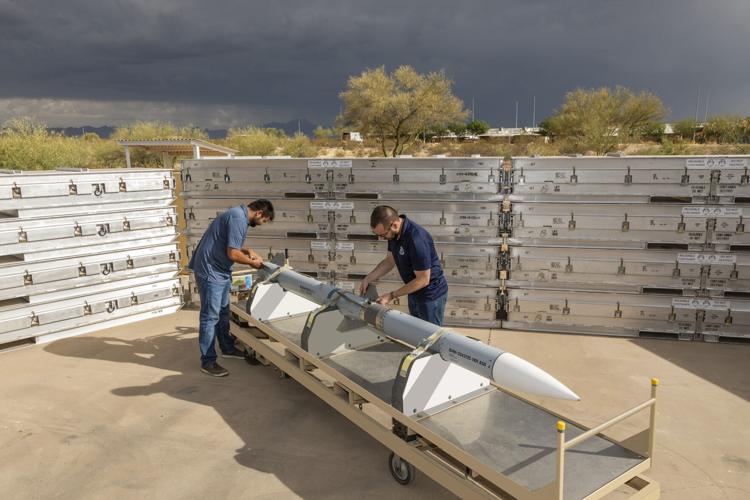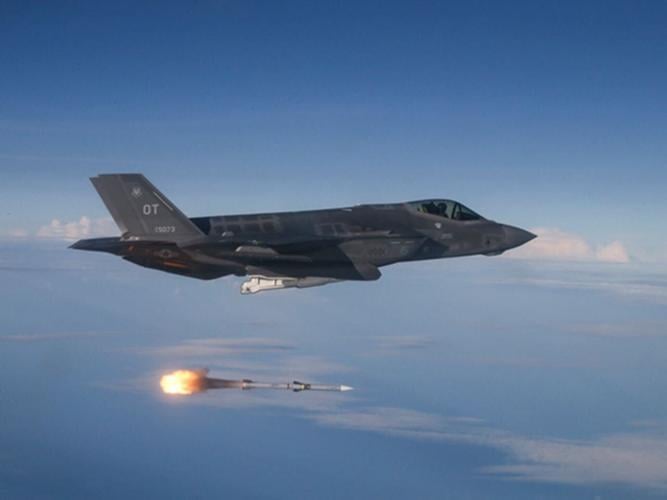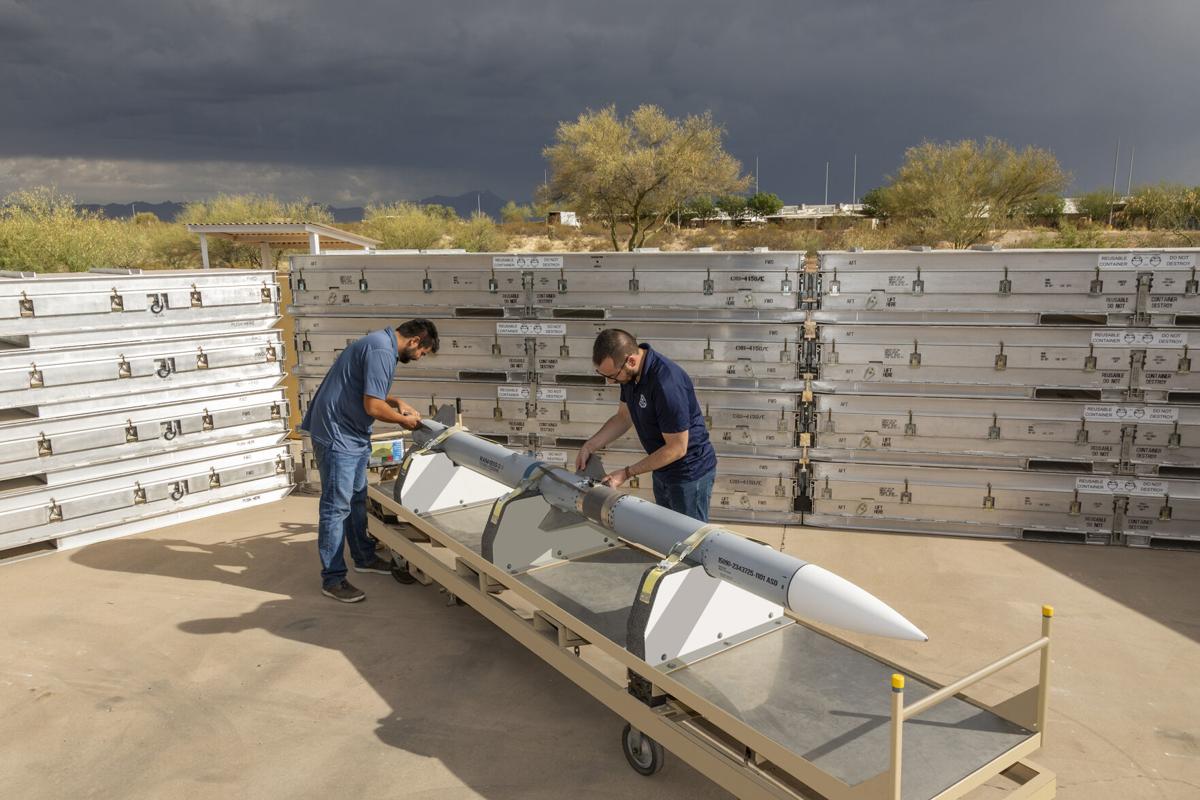For more than three decades, Raytheon’s factory in Tucson has produced the main long-range air combat missile, the Advanced Medium-Range Air-to-Air Missile or AMRAAM, for U.S. and allied air forces.
Now, despite significant AMRAAM upgrades over the years, emerging threats are driving the Pentagon to replace or supplement the combat-proven weapon.
But Raytheon says it’s confident that with a recent refit program, the AMRAAM will remain relevant for years to come — even as a new generation of air-to-air combat missiles under development takes to the sky.
John “Clyde” Thayer, Raytheon’s AMRAAM program head and a retired Air Force fighter pilot, said today’s AMRAAM has evolved far beyond the missile he used while flying F-15s during his 22-year military career.
“It definitely is not the missile that I started out with,” Thayer said. “If we go back to the original missile, it was designed to meet a certain performance specification and beat a certain threat. The threat has evolved over the last three decades, obviously.”
“We have evolved to not just what the current threat is, but what we also expect the threat to be in the near future,” he said. “We’re always trying to figure out how we defeat ourselves, then we can counteract that.”
Standard equipment
The AMRAAM was originally developed in Tucson by Hughes Aircraft, which was acquired by Raytheon in 1997, and it was first deployed in 1991.
Since then, the all-weather, radar-guided AIM-120 AMRAAM has filled an imperative need for a “beyond-visual-range” air-to-air missile, which can target enemy planes or other aircraft long before they come into view and lock on them independently.
The AMRAAM, which costs about $1 million per copy, has long been standard equipment for U.S. Air Force and Navy fighters and is in use by 42 allied nations, often paired with Raytheon’s shorter-range, heat-seeking AIM-9 Sidewinder missile.
The mid-1990s saw the rollout of the AMRAAM AIM-120C versions with improved homing capabilities and a longer range.
The next-generation AIM-120D missiles became operational in 2015, adding 50% more range with subsequent versions adding features including a two-way data link to aid targeting and more accurate GPS-aided guidance.
While the AMRAAM’s range is classified and depends on conditions, the Air Force has said earlier versions had a range of 20-plus miles, while the latest versions reportedly can extend to nearly 100 miles.
The AMRAAM scored its first intercept in combat in 1992, when a U.S. F-16 fighter used one to down an Iraqi MiG-25 that had violated the no-fly zone the U.S. and its coalition partners enforced over Iraq at the time. Overall, the AMRAAM has been credited with 16 aircraft “kills” by U.S. and allied forces over Iraq, Bosnia, Kosovo, India and Syria.

An Air Force F-35A fighter jet fires an Advanced Medium Range Air-to-Air missile during a 2018 test flight over the Gulf of Mexico.
Three-way refresh
Now, Raytheon and the Air Force are in the final stages of testing the AMRAAM’s latest upgrade, known as the “Form, Fit, Function Refresh,” or F3R, which replaces multiple circuit boards and other hardware threatened by obsolescence, as well as a major software update.
Last July, Raytheon and the Air Force announced the successful first test flight of an AMRAAM AIM-120D with the F3R upgrades, after delays of more than a year linked to hardware issues.
Though a total of five test shots are planned before the F3R version is declared operational, Raytheon last September was awarded a three-year, $972 million contract to produce the upgraded AMRAAM for the U.S. Air Force and Navy and 19 allied countries.
New missiles
Meanwhile, the Pentagon is moving ahead with the development of new air-to-air missiles to meet a perceived threat from China, which has reportedly developed missiles with longer range than the AMRAAM as well as advanced radar-jamming technology.
In response, the Air Force and Navy have tapped Lockheed Martin to develop the AIM-260 Joint Advanced Tactical Missile (JATM), a longer-range air combat missile with advanced capabilities.
While Air Force officials have acknowledged that flight testing of the AIM-260 has been ongoing, ahead of production that was supposed to start last year, many details of that program remain shrouded in secrecy.
Raytheon, which has developed an extended-range AMRAAM version as well as a ground-launched variant for air-defense systems, is involved in the early development of two other new missile concepts.
In December, Raytheon was awarded a $21 million Air Force contract to develop critical subsystem technologies for two new air-combat weapons, called the Extended Range Air-to-Air Missile and Compact Air-to-Air Missile systems.
In 2019, Raytheon unveiled the Peregrine air-to-air missile, which features greater speed and range and advanced navigation and guidance in an airframe less than half the size of an AMRAAM, allowing fighters to carry twice as many missiles.
In September, Boeing was awarded a similar contract worth up to $9.8 million for subsystem development of the compact and extended-range air combat missiles.
Keeping foes at bay
A longtime military analyst said the Air Force and Navy need a beyond-visual-range air combat missile with a range longer than its adversaries to keep its fighters out of reach until it’s too late.
“The Air Force’s basic approach to air warfare is to use radar to see first and fire first, which requires a beyond visual-range-missile that can operate independently of the aircraft launching it, hence the phrase, ‘fire and forget,’” said Loren Thompson, chief operating officer of the Lexington Institute, a Virginia-based think tank supported by Raytheon and other defense contractors.
“The problem the Air Force faces today is that China is producing its own beyond-visual-range missiles that will likely have greater range than AMRAAM’s,” Thompson said. “That undercuts the U.S. goal of seeing first and firing first. So the Air Force and sea services need a weapon with greater reach that still can fit into the allotted space on tactical aircraft.”
Thompson said the successor to the AMRAAM won’t be significantly bigger, but it will have greater range and advanced features for countering enemy efforts to jam its sensor.
Raytheon’s Thayer said the AMRAAM will remain an important part of the U.S. arsenal for years, even as Lockheed’s AIM-260 JATM begins production.
“I think it will be complementary for decades to come, because it’s hard to do and it’s hard to do at scale, so it’ll be a while before their factory is up and running before they can produce the number that we can produce right now,” he said.
While Air Force officials have previously said the service plans to wind down its AMRAAM buys by 2027, allied nations will continue to rely on the missile for years to come, Thayer said.
A mainstay air-combat weapon used by the U.S. and more than 40 allied nations, the Advanced Medium Range Air-to-Air Missile has been upgraded over three decades to meet emerging threats.






